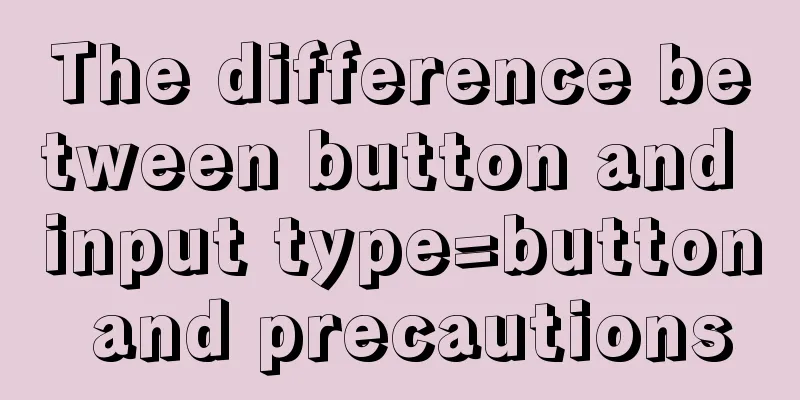Detailed explanation of JavaScript BOM composition and common events

1. BOM1. What is BOM? BOM (Browser Object Model) is a browser object model that provides objects that interact with the browser window independently of the content. Its core object is window. The BOM consists of a series of related objects, and each object provides many methods and properties. BOM lacks standards. The standardization organization for JavaScript syntax is ECMA, and the standardization organization for DOM is W3C. BOM was originally part of the Netscape browser standard. 2. Composition of BOM As shown in the following figure:
The window object is the top-level object of the browser and it has a dual role. It is an interface for JS to access the browser window. Another global object. Variables and functions defined in the global scope will become properties and methods of the window object. Window can be omitted when calling. alert(), prompt(), etc. are all window object methods. We can call the window object to see what properties and methods it has. As shown below: console.log(window); The intercepted part is as follows:
It can be seen that the variables and functions defined in the global scope will become properties and methods of the window object. 2. Common events of window objects1. Window loading eventWe know that in the execution mechanism of JavaScript, the execution of code is executed in order from top to bottom, so if we want to add a click event to a button, we can only set the button first, and then get the button to operate, as follows:
<body>
<button>Click</button>
<script>
var btn = document.querySelector('button');
btn.onclick = function(){
alert('You just clicked!')
}
</script>
</body>
Click the effect:
If we want to place the bound click event at the front of the page, it is obviously not possible. What should we do then? At this time, we can complete it through our window loading event.
window.onload = function(){}
//or window.addEventListener("load",function(){});
As in the example above:
<body>
<script>
window.onload = function(){
var btn = document.querySelector('button');
btn.onclick = function(){
alert('You just clicked!')
}
}
</script>
<button>Click</button>
</body>
The click effect can also be achieved at this time.
It should be noted that: 1. With 2. The traditional 3. If you use addEventListener, there is no restriction. What if we also have a click event at this time and want to put its operation in front of the element? Let’s try it:
<script>
window.onload = function(){
var btn = document.querySelector('button');
btn.onclick = function(){
alert('You clicked again!')
}
}
window.onload = function(){
alert('Hello')
}
</script>
<button>Click</button>
</body>
What is the print result?
It can be found that the first event will be overwritten by the second event. This is, we can operate in another way, as follows:
document.addEventListener('DOMContentLoaded',function(){})
The code is:
<script>
document.addEventListener('DOMContentLoaded',function(){
var btn = document.querySelector('button');
btn.onclick = function(){
alert('You clicked again!')
}
alert('Hello')
})
</script>
<button>Click</button>
</body>
The running results are:
The 2. Adjust window size event On many websites, we will find that when we change the window size, the content inside will also change accordingly. How is this done? Here we will use our window resize event. Its format is:
//(1)
window.onresize = function(){}
//(2)
window.addEventListener("resize",function(){});
window.onresize is a window resize loading event, and the processing function is called when it is triggered. For example: There is a box in the page. When the width of our page is less than 800px, let the color of this box turn purple.
<!DOCTYPE html>
<html lang="en">
<head>
<meta charset="UTF-8">
<meta http-equiv="X-UA-Compatible" content="IE=edge">
<meta name="viewport" content="width=device-width, initial-scale=1.0">
<title>Document</title>
<style>
div {
width: 100px;
height: 100px;
background-color: red;
}
</style>
</head>
<body>
<div></div>
<script>
div = document.querySelector('div')
window.onresize = function(){
console.log(window.innerWidth);
if(window.innerWidth <= 800){
div.style.backgroundColor = 'green';
}
}
</script>
</body>
</html>
The print result is:
Similarly, we can also perform the above operations through SummarizeThis article ends here. I hope it can be helpful to you. I also hope you can pay more attention to more content on 123WORDPRESS.COM! You may also be interested in:
|
<<: Pure CSS to achieve the effect of picture blinds display example
>>: MySQL5.7 single instance self-starting service configuration process
Recommend
Vue+el-table realizes merging cells
This article example shares the specific code of ...
A brief discussion on what situations in MySQL will cause index failure
Here are some tips from training institutions and...
Create a code example of zabbix monitoring system based on Dockerfile
Use the for loop to import the zabbix image into ...
Write a mysql data backup script using shell
Ideas It's actually very simple Write a shell...
Detailed explanation of the difference between tinyint and int in MySQL
Question: What is the difference between int(1) a...
Do you know how to use vue-cropper to crop pictures in vue?
Table of contents 1. Installation: 2. Use: 3. Bui...
Implementing CommonJS modularity in browsers without compilation/server
Table of contents introduction 1. What is one-cli...
Detailed explanation of primitive values and reference values in ECMAScript
Table of contents Preface What are dynamic proper...
Start nginxssl configuration based on docker
Prerequisites A cloud server (centOS of Alibaba C...
Install CentOS system based on WindowsX Hyper-V
At present, most people who use Linux either use ...
Detailed process of zabbix monitoring process and port through agent
Environment Introduction Operating system: centos...
CSS3 realizes draggable Rubik's Cube 3D effect
Mainly used knowledge points: •css3 3d transforma...
CocosCreator Skeleton Animation Dragon Bones
CocosCreator version 2.3.4 Dragon bone animation ...
GZIP compression Tomcat and improve web performance process diagram
1. Introduction I recently worked on a project an...
Summary of several common ways to abbreviate javascript code
Table of contents Preface Arrow Functions Master ...
















